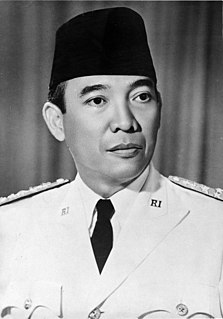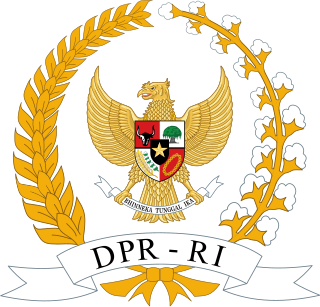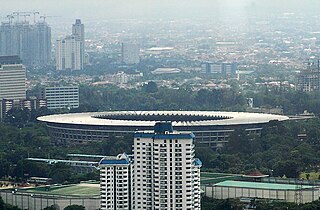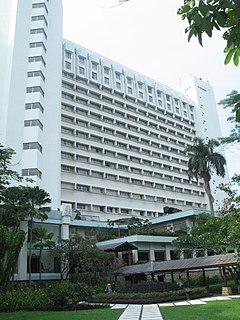
Sukarno was an Indonesian statesman, orator, revolutionary, and nationalist who was the first president of Indonesia, serving from 1945 to 1967.

The People's Representative Councilof the Republic of Indonesia is one of two elected chambers of the People's Consultative Assembly, the national legislature of Indonesia. It is considered as the lower house, while the Regional Representative Council serve as the upper house; while the Indonesian constitution does not explicitly mention the divide, the DPR enjoys more power, privilege, and prestige compared to the DPD.

Jakarta is Indonesia's capital and largest city. Located on an estuary of the Ciliwung River, on the northwestern part of Java, the area has long sustained human settlement. Historical evidence from Jakarta dates back to the 4th century CE, when it was a Hindu settlement and port. The city has been sequentially claimed by the Indianized kingdom of Tarumanegara, the Hindu Kingdom of Sunda, the Muslim Sultanate of Banten, and by Dutch, Japanese and Indonesian administrations. The Dutch East Indies built up the area before it was taken during World War II by the Empire of Japan and finally became independent as part of Indonesia.

The MPR/DPR/DPD Building, also known as the MPR/DPR Building is the seat of government for the Indonesian legislative branch of government, which consists of the People's Consultative Assembly the People's Representative Council and the Regional Representatives Council.

The Jakarta Art Building, historically known as Schouwburg Weltevreden, is a concert hall in Sawah Besar, Central Jakarta, Indonesia, built during the colonial period in Batavia, Dutch East Indies.

Bung Karno Sports Arena, formerly named Senayan Sports Arena from 1969 to 2001 and Asian Games Complex on its early days, is a sports complex located in Gelora, Central Jakarta, Indonesia. It is usually misperceived to be located at Senayan, South Jakarta, hence its former name. The sports complex hosts main stadium, secondary stadium, the Sports Palace, football fields, aquatic stadium, tennis stadiums, hockey, baseball and archery fields, and several indoor gymnasiums. The complex was built in 1960 for the 1962 Asian Games and recently underwent a major reconstruction for the 2018 Asian Games and Asian Para Games.

Jalan M.H. Thamrin or Jalan Thamrin is a major thoroughfare in Jakarta, Indonesia. The road is located at the center of Jakarta, running from the north end of Jalan Jenderal Sudirman at West Flood Canal at the south end to the roundabout near Arjuna Wijaya Statue Jakarta at the north end. Developed in the 1950s, the road was a landmark of post-colonial Indonesia and continues to have a prominent importance in Jakarta.

Jalan H.R. Rasuna Said or Jalan Rasuna Said is one of the main avenues of Jakarta, Indonesia. It was constructed during the 1970s. It is located in the Golden Triangle of Jakarta. The road was named after Hajjah Rangkayo Rasuna Said, a National Hero of Indonesia. The road runs 4.9 km (3.0 mi) from Menteng, Central Jakarta, to Tendean, Mampang Prapatan, South Jakarta.

PT Sarinah (Persero) is an Indonesian retail company owned by PT Aviasi Pariwisata Indonesia (Persero) (InJourney), a state-owned holding company. Its flagship store, Sarinah Building in M.H. Thamrin Street of Central Jakarta, was the first skyscraper to be built in Jakarta as well as the first modern department store in the city. In addition to Thamrin, Sarinah also has a number of outlets located in Pejaten Village at South Jakarta, Banyumanik at Semarang and Malang.

The Plaza Semanggi is a commercial complex at Semanggi Interchange in South Jakarta, Indonesia. The commercial center includes a shopping mall, an auditorium Balai Sarbini and office tower Gedung Veteran RI. The auditorium and office tower were constructed in 1973. The name The Plaza Semanggi more correctly refers to the shopping mall which was opened in 2004 with the refurbishment of Balai Sarbini and Gedung Veteran RI.

Pancasila Building is a historic building located in Central Jakarta, Indonesia. The name "Pancasila" refers to the speech delivered by Sukarno in the building on which he explained the concept of Pancasila, a philosophical concept which would be the foundation of the Indonesian nation, on June 1, 1945. Built in the early 1830s, the building is one of the many 19th-century colonial landmarks in Jakarta. The Pancasila Building currently belongs to and is under the preservation of the Indonesian Ministry of Foreign Affairs.

Jakarta City Hall is the seat of the Jakarta City government. The complex contains the official office of the governor and the vice governor of Jakarta, and the main administrative office. Jakarta City Hall is located south of Merdeka Square.
Soejoedi Wirjoatmodjo was an architect in Indonesia who was active during the late 1960s and mid 1970s. In 1964, he was asked by President Sukarno to be in charge as chief architect for national architectural projects in the Jakarta. Soejoedi is considered to be the first native architect of the Post-Colonial period that is considered as a proponent of modernist architects and designers.

Jalan Jenderal Gatot Subroto(Gatot Subroto Avenue) is one of the major road in Jakarta, Indonesia. The road starts from Dirgantara statue in South Jakarta, which crosses 13 administrative villages and ends at Pejompongan, Central Jakarta. The road is named after National Hero of Indonesia General Gatot Subroto. The road was constructed in 1960s. The road runs parallel with Jakarta Inner Ring Road. The location of the road is within the Golden Triangle CBD of Jakarta. Many important office buildings and skyscrapers are situated along the road.
The Golden Triangle of Jakarta is a roughly triangular area in the center of Jakarta, Indonesia, extending from Central Jakarta to South Jakarta. Most of the city's foreign embassies and tallest skyscrapers are located in the area, which is the main CBD of Jakarta. The area is bordered by main avenues of Jakarta: Jalan M.H. Thamrin-Jalan Jenderal Sudirman (north-southwest), Jalan H.R. Rasuna Said (north-southeast), and Jalan Jenderal Gatot Subroto (east-west). There are many other roads bisecting the area. The Golden Triangle's commercial areas include SCBD, Mega Kuningan, Rasuna Epicentrum and Kuningan Persada. The Golden Triangle is one of the fastest evolving CBDs in the Asia-Pacific region.

Semanggi Interchange is a major road junction in Jakarta, Indonesia which connects Central Jakarta, South Jakarta, East Jakarta and West Jakarta without any traffic lights. Semanggi intersection has the shape of four-leaved cloverleaf. Two main roads of the city Gatot Subroto Road and Sudirman Road intersect at this cloverleaf interchange. This is a landmark and an important arterial road in the Golden Triangle of Jakarta, an area of Jakarta's business district.

Taman Proklamasi is a park complex located in Central Jakarta, Indonesia. The park is located at the former property of Sukarno at what was known as the house at Jalan Pegangsaan Timur 56. The house, now demolished, is where the Proclamation of Indonesian Independence was first read by Sukarno.

West Irian Liberation Monument is a postwar modernist monument located in Jakarta, Indonesia. It is located in the center of Lapangan Banteng in Sawah Besar, Central Jakarta. Sukarno, then President of Indonesia, commissioned the monument in 1963 following the West New Guinea dispute in which Indonesia received the territory of Western New Guinea from the Netherlands.

Hotel Borobudur is a five star hotel and serviced apartment located in Central Jakarta, Indonesia. Conceived in the 1960s by President Sukarno, it was meant to be the second international-standard hotel to be built in the newly independent country. The hotel is located near Lapangan Banteng, which during the colonial times was the center of what was the military-European colonial neighborhood of Weltevreden. At its opening in 1974, as the Hotel Borobudur Inter-Continental, it was the largest hotel in Jakarta.

Sarinah is a 74-metre tall 15-floor department store in Gondangdia, Menteng, Central Jakarta, Indonesia. It was the first skyscraper to be built in Jakarta.

















